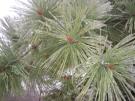What effect will
the unusually mild autumn weather have on our outdoor plants?
The answer is, "It all depends on what comes next."
Plants in our region of the world have adapted to living
through annual cycles of warm and cold weather. An important
part of this adaptation is the practice of developing cold
hardiness. Ideally, the level of hardiness increases gradually
starting in the fall as the temperatures get colder and
reaching its peak by the depths of winter. Then, the process
reverses and hardiness gradually decreases as the temperatures
warm into the spring.
 Woody
perennials such as trees and
live with much of
their tissue exposed to the open air. To survive, woody plants
have developed the ability to "harden off." Plant tissues vary
in the degree of cold hardiness they can attain. Generally
speaking, a tree trunk will be hardier than a branch. A branch
can tolerate more cold than a twig. Buds are more easily
damaged than twigs and flowers are the least hardy plant
tissue of all.
Woody
perennials such as trees and
live with much of
their tissue exposed to the open air. To survive, woody plants
have developed the ability to "harden off." Plant tissues vary
in the degree of cold hardiness they can attain. Generally
speaking, a tree trunk will be hardier than a branch. A branch
can tolerate more cold than a twig. Buds are more easily
damaged than twigs and flowers are the least hardy plant
tissue of all.
A flower bud produced in late summer may be killed if
exposed to a 20 degree night in October. This same bud, when
properly hardened off, will easily survive minus 20 degrees in
February. Then, in the spring as it loses hardiness, a mild
frost of 27 degrees in early May will often kill the bud.
Unfortunately, our weather does not always honor the
plant's hardiness schedule. Sudden changes from one extreme to
another are the most destructive. A mild autumn retards the
hardening process so that a sudden drop to zero degrees in
late December will cause as much damage as 30 below zero might
in February. Likewise a March warm spell where temperatures
rise into the 60's for a few days followed by a return to
freezing temperatures can cause great damage to buds.
What can you do to prevent injury from these sudden
changes? Unfortunately, for existing trees and shrubs, there
are few options. The best approach is to consider the
hardiness of the plant before it is added to your landscape.
USDA climate Zone 5 means plants must be able to routinely
withstand a minimum temperature of -10 to -20 degrees
Fahrenheit. Areas to our south are Zone 6 and do not
experience such low temperatures. To our north is Zone 4 where
plants must be even hardier.
Too often, people purchase plants from other climate zones
and expect them to survive our harsher weather. Care must be
taken when purchasing woody plants from the Pacific Northwest
or from the South to make sure they are rated as hardy for our
climate. Flowering dogwood trees raised from seeds grown in
Kentucky, for example, may have difficulty surviving
Miidewestern winters.
Ornamental plants such as Japanese maples,
rhododendrons,
azaleas, boxwood and
roses also tend to need protected sites.
They may be able to withstand cold temperatures but winter
winds will dry tender tissues and cause damage. Natural wind
screens by other plants, buildings and temporary windscreens
of burlap can help them survive.







